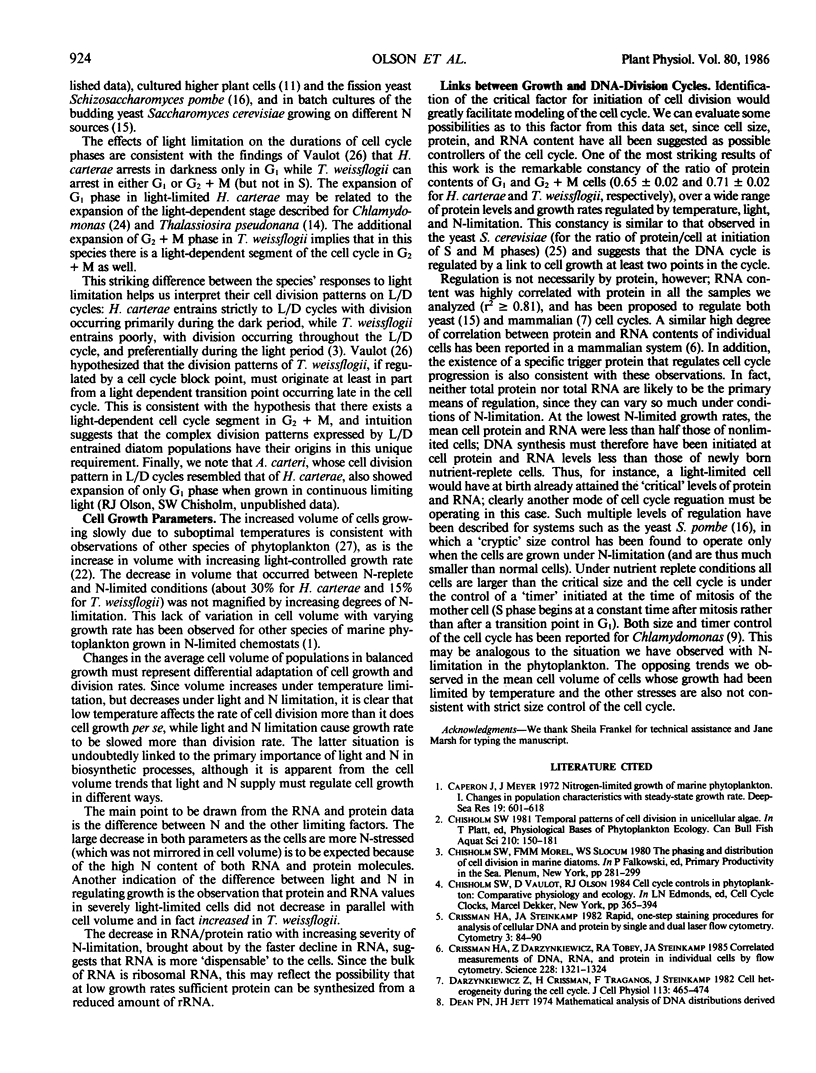Abstract
Cell cycle phase durations of cultures of Hymenomonas carterae Braarud and Fagerl, a coccolithophore, and Thalassiosira weissflogii Grun., a centric diatom, in temperature-, light- or nitrogen-limited balanced growth were determined using flow cytometry. Suboptimal temperature caused increases in the duration of all phases of the cell cycle (though not equally) in both species, and the increased generation time of nitrogen-limited cells of both species was due almost wholly to expansion of G1 phase. In H. carterae light limitation caused only G1 phase to expand, but in T. weissflogii both G2 + M and G1 were affected. These results are discussed in relation to cell division phasing patterns of these two species and to models of phytoplankton growth. Simultaneous measurements of protein and DNA on individual cells indicated that under all conditions, the protein content of cells in G1 was a constant proportion of that of G2 + M cells. Simultaneous measurements of RNA and protein on each cell indicated that the amounts of these two cell constituents were always tightly correlated. Under conditions of nitrogen limitation both protein and RNA per cell decreased to less than one-third of the levels found in nonlimited cells. This indicates, at least for nitrogen-replete cells, that neither protein nor RNA levels are likely to act as the trigger for cell cycle progression. Strict control by cell size is also unlikely since mean cell volume decreased as growth rates were limited by light and nitrogen supply, but increased with decreasing temperature.
Full text
PDF







Selected References
These references are in PubMed. This may not be the complete list of references from this article.
- Crissman H. A., Darzynkiewicz Z., Tobey R. A., Steinkamp J. A. Correlated measurements of DNA, RNA, and protein in individual cells by flow cytometry. Science. 1985 Jun 14;228(4705):1321–1324. doi: 10.1126/science.2408339. [DOI] [PubMed] [Google Scholar]
- Crissman H. A., Steinkamp J. A. Rapid, one step staining procedures for analysis of cellular DNA and protein by single and dual laser flow cytometry. Cytometry. 1982 Sep;3(2):84–90. doi: 10.1002/cyto.990030204. [DOI] [PubMed] [Google Scholar]
- Darzynkiewicz Z., Crissman H., Traganos F., Steinkamp J. Cell heterogeneity during the cell cycle. J Cell Physiol. 1982 Dec;113(3):465–474. doi: 10.1002/jcp.1041130316. [DOI] [PubMed] [Google Scholar]
- Dean P. N., Jett J. H. Mathematical analysis of DNA distributions derived from flow microfluorometry. J Cell Biol. 1974 Feb;60(2):523–527. doi: 10.1083/jcb.60.2.523. [DOI] [PMC free article] [PubMed] [Google Scholar]
- Donnan L., John P. C. Cell cycle control by timer and sizer in Chlamydomonas. Nature. 1983 Aug 18;304(5927):630–633. doi: 10.1038/304630a0. [DOI] [PubMed] [Google Scholar]
- Fantes P. A. Control of cell size and cycle time in Schizosaccharomyces pombe. J Cell Sci. 1977 Apr;24:51–67. doi: 10.1242/jcs.24.1.51. [DOI] [PubMed] [Google Scholar]
- Johnston G. C., Singer R. A. RNA synthesis and control of cell division in the yeast S. cerevisiae. Cell. 1978 Aug;14(4):951–958. doi: 10.1016/0092-8674(78)90349-5. [DOI] [PubMed] [Google Scholar]
- Nasmyth K. A. A control acting over the initiation of DNA replication in the yeast Schizosaccharomyces pombe. J Cell Sci. 1979 Apr;36:155–168. doi: 10.1242/jcs.36.1.155. [DOI] [PubMed] [Google Scholar]
- Rossow P. W., Riddle V. G., Pardee A. B. Synthesis of labile, serum-dependent protein in early G1 controls animal cell growth. Proc Natl Acad Sci U S A. 1979 Sep;76(9):4446–4450. doi: 10.1073/pnas.76.9.4446. [DOI] [PMC free article] [PubMed] [Google Scholar]
- Slater M. L., Sharrow S. O., Gart J. J. Cell cycle of Saccharomycescerevisiae in populations growing at different rates. Proc Natl Acad Sci U S A. 1977 Sep;74(9):3850–3854. doi: 10.1073/pnas.74.9.3850. [DOI] [PMC free article] [PubMed] [Google Scholar]
- Spudich J. L., Sager R. Regulation of the Chlamydomonas cell cycle by light and dark. J Cell Biol. 1980 Apr;85(1):136–145. doi: 10.1083/jcb.85.1.136. [DOI] [PMC free article] [PubMed] [Google Scholar]
- Vanoni M., Vai M., Popolo L., Alberghina L. Structural heterogeneity in populations of the budding yeast Saccharomyces cerevisiae. J Bacteriol. 1983 Dec;156(3):1282–1291. doi: 10.1128/jb.156.3.1282-1291.1983. [DOI] [PMC free article] [PubMed] [Google Scholar]
- Yanishevsky R. M., Stein G. H. Regulation of the cell cycle in eukaryotic cells. Int Rev Cytol. 1981;69:223–259. doi: 10.1016/s0074-7696(08)62324-4. [DOI] [PubMed] [Google Scholar]


